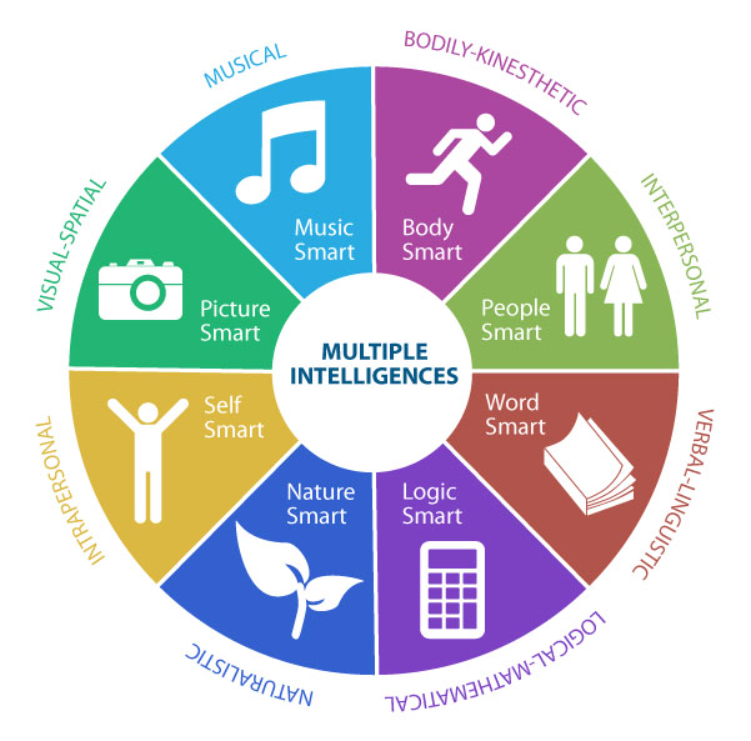(2.1)Howard Gardner's Multiple Intelligences theory- Harnessing Students' Interests to Craft Meaningful Learning Tasks
- Mu Mei Hsueh
- Aug 26, 2023
- 4 min read
Updated: Feb 21, 2024

Image by The intelligence modalities, Wikipedia from https://en.wikipedia.org/wiki/Theory_of_multiple_intelligences
1. What are some ways a foreign language teacher can adapt instruction to students' learning style with the Multiple Intelligences theory?
The Multiple Intelligences theory, proposed by Howard Gardner, suggests that individuals have various distinct types of intelligences that guide their learning preferences and strengths. Adapting foreign language instruction to cater to these intelligences can enhance student engagement and learning outcomes. Here's how a foreign language teacher can incorporate the Multiple Intelligences theory:
1. Linguistic Intelligence:
For students strong in linguistic intelligence, emphasize reading, writing, and spoken language activities.
Assign reading assignments, encourage writing essays or journals, and conduct debates or discussions on language-related topics.
Integrate storytelling, role-plays, and creative writing exercises to engage linguistic learners.
Questioning: Encourage writers to ask themselves questions about the topic. What, why, how, when, and where questions can help explore different angles and generate ideas.
Role Play or Perspective Shift: Have writers imagine they are a different person, such as an expert, a child, or someone from a different culture. This can help them explore the topic from new angles.
Word Association: Give writers a word related to the topic and ask them to write down the first words or ideas that come to mind. This can help them break through mental blocks and generate ideas.
2. Logical-Mathematical Intelligence:
Use a structured approach to teaching grammar rules and language patterns.
Incorporate riddle(謎語), logic puzzles, word games, and analytical exercises that involve language patterns and problem-solving.
Break down complex language concepts into logical steps and sequences.
Comparisons and Contrasts: Prompt writers to compare the topic with something similar or contrasting. This can help them identify unique aspects and generate ideas from different angles.
3. Visual-Spatial Intelligence:
Provide visual aids such as charts, diagrams, maps, and videos to aid comprehension.
Use multimedia resources, interactive apps, and visual storytelling to engage visual learners.
Encourage students to create visual representations of vocabulary words and concepts.
Mind Mapping: Create a visual representation of the topic by placing the main idea in the center and branching out with related subtopics, ideas, and associations. This technique helps writers see connections between different aspects of the topic.
Visual Aids: Use images, photographs, diagrams, or visual prompts related to the topic. Visual cues can inspire ideas and help writers visualize different aspects of the topic.
4. Musical Intelligence:
Integrate songs, rhymes, and rhythm-based activities into language lessons.
Utilize music with lyrics in the target language to enhance listening skills and pronunciation.
Have students create their own language-related songs or jingles.
5. Bodily-Kinesthetic Intelligence:
Incorporate physical movement into language learning through gestures, role-plays, and interactive games. *Total Physical Response (TPR).
Use drama and phsical activities to reinforce vocabulary and language structures.
Create hands-on projects or activities that involve crafting or manipulating language-related objects.
6. Interpersonal Intelligence:
Foster group discussions, debates, and collaborative projects that ncourage interaction among students.
Organize language exchange programs, pair work, and group activities to promote language practice and cultural exchange.
Encourage students to share their perspectives and experiences related to the language and culture.
Brainstorming: Have writers jot down all the ideas, words, phrases, and associations related to the topic. This can be done individually or in a group setting, and it can help stimulate creativity and generate a range of ideas.
7. Intrapersonal Intelligence (內在的):
Provide opportunities for self-reflection and self-assessment in language learning.
Encourage students to set personal language goals and track their progress.
Offer independent research projects or creative writing assignments that align with individual interests.
8. Naturalistic Intelligence (自然主義):
Incorporate nature-related vocabulary and topics into language lessons.
Use outdoor activities, field trips, and nature-themed readings to engage naturalistic learners.
Encourage discussions about cultural practices related to the natural environment.
9. Existential Intelligence (存在主義):
Explore philosophical (哲学) and cultural aspects of the language, discussing existential themes in literature and conversation.
Encourage reflective writing and discussions about the deeper meanings of language and cultural expressions.
Integrate topics related to ethics, beliefs, and values within the context of language learning.
Adapting instruction based on the Multiple Intelligences theory not only accommodates diverse learning styles but also helps students develop a well-rounded set of language skills. It's important to assess students' strengths and preferences and incorporate a variety of activities that engage different intelligences throughout your teaching approach.
2. What are some ways that students' interests could be used to create meaningful tasks?
1. Learning with choice
Show and tell: Students are encouraged to bring items they have selected that relate to the learning topic to class and describe them to their classmates.
Choice in Assessment: Offer options for assessments, such as different types of assignments or different ways to demonstrate understanding. This allows students to choose tasks that resonate with their interests and strengths.
2. Making Real World Connections (Real-World Applications): Connect the subject to real-world situations related to students' interests. For instance, if a student loves sports, integrate math by analyzing game statistics or physics by discussing the science of sports equipment.
3. Group Projects: Allow students to form groups based on shared interests to work on collaborative projects. This encourages teamwork and can lead to innovative outcomes.
4. Field Trips or Virtual Tours: Organize trips or virtual experiences related to students' interests. This could include visits to museums, industries, or cultural sites connected to the subject.
5. Personal Reflection: Have students reflect on how the subject matter relates to their interests, goals, and experiences. This encourages deeper thinking and personal connections.



Comments